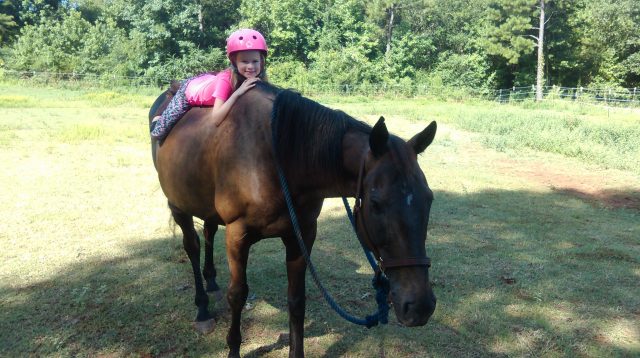
Surviving Summer Like a Texan Equestrian
It’s hot, y’all, and we’re all just trying to survive.
According to the National Oceanic and Atmospheric Administration, the average temperature for the U.S. during the summer of 2021 was hotter than the Dust Bowl of 1936, with many states experiencing record breaking temperatures. This year, The Washington Post reported the summer will be hotter, longer and more dangerous. While this all seems a bit doom and gloom, we can make the summer more survivable. Here are a few tips from the Lone Star State.
Fresh Water
Access to water is critical, and while it’s not always ice cold, troughs on my property are checked twice a day, every day, for two reasons: dead squirrels and live larvae.
Squirrels in their pursuit to quench their own thirst, crawl into my troughs and drown. Once I even found two squirrels in the same trough, which I immediately assumed was one squirrel trying to save its friend’s life, resulting in a double tragedy. I cried a little. I’m not embarrassed.
Mosquitoes, flies and gnats, on the other hand, will never earn my sympathy. Using a cheap pool skimmer, I regularly scrape at the sides and bottoms of my troughs. If I come up with any tiny wriggling brown or red things, everything has to be dumped, scrubbed and refilled.
Pest Control
Flies, mosquitoes and midges are an ongoing plague in Houston, with the bug season lasting an average 11 months a year. A plethora of products are available and I like to rotate them, much like dewormers, for best efficacy.
I also prefer more natural products that include apple cider vinegar and Neem oil, which works fantastically against gnats. I occasionally add peppermint or lavender essential oils to the mix as well. Horse flies especially loathe lavender and everything from ticks to ants hates peppermint.
If you’re up for a DIY project, here’s an amazing recipe via SavvyHorseWoman:
- 16 oz. Spray Bottle
- 2 cups Raw Apple Cider Vinegar
- 1 Tbs. Mineral Oil
- 1/2 Tbs. Liquid Dish Soap
- 30-40 drops of any combination of the following oils: Citronella, Eucalyptus, Lemon Grass, Basil, Peppermint, Cedarwood, Lavender, Tea Tree, Rosemary
- Add all ingredients to the spray bottle.
- Gently shake before use.
- Spray on horses and livestock as needed, being careful to avoid the eyes and nose.
- Store in a cool, dark place.
Wash, Rinse, Repeat
The average temps during a Houston summer are usually well into the 90s, if not the triple digits, with humidity levels hovering between 90 and 60%. Those conditions lead to all kinds of gunk and funk.
My mare that is ridden regularly gets rinsed every day after her ride — don’t forget to rinse and scrape, rinse and scrape for the most effective cooling — while my two retirees get full baths every two to three days. I’ve found that a midday wash has more benefits than one later in the day. Being clean seems to keep them noticeably cooler and more comfortable through steamy afternoons, resulting in less sweat buildup.
I wash everyone with a generic dandruff shampoo to control “cannon crud” and other little skin ailments — a tip I learned from a veterinarian after a particularly heinous hurricane season.
Get Your Electrolytes
There are plenty of amazing products available for regular electrolyte supplementation, but my horses’ personal favorite summer treat is watermelon. The juicy fruit is around 90% water and has important electrolytes like potassium. Some horses only eat the red flesh while others will consume it rind and all, so make sure you remove grocery store stickers.
Save a few slices for yourself, too, because I highly recommend this Watermelon Margarita recipe courtesy of The New York Times.
Fan or Shade?
Whether you choose to bring your horse indoors during the hottest part of the day or turn them out in a pasture with plenty of shade trees, don’t forget to check that ventilation is adequate or that they’re actually using the shade.
Long story short, I have owned horses — let me be honest, they were all geldings — that didn’t understand the concept. They would just stay out in the full sun all day stuffing their faces with summer grass, totally disregarding their health and well-being. The problem solved itself when I introduced a mare into the herd and she taught them better.
But some horses might need to be brought into the barn for their own good during the hottest times of the day, generally between 10am and 4pm.
Ride … But Relax Too.
I continue to ride five days a week throughout the heat of summer, but the work doesn’t consist of high intensity training. We walk a lot. We “check fences” on the perimeter of the property, a task my alpha mare really seems to enjoy. We work on proprioception exercises. We work on trail obstacles, like opening and closing a gate from the saddle, walking over a bridge, or side passing a log, all of which can be setup in the shade of a large tree. We practice standing still.
It’s slow. It’s calm. It trains the brain more than the body. But it’s also important work that will advance your riding in the fall when temperatures finally start to cool down.
Go Riding
…and don’t forget to enjoy a watermelon margarita afterward.
Amanda Uechi Ronan is an author, equestrian and wannabe race car driver. Follow her on Instagram @uechironan.












